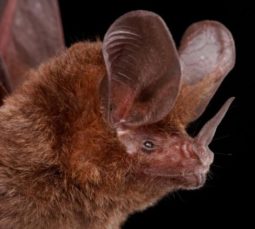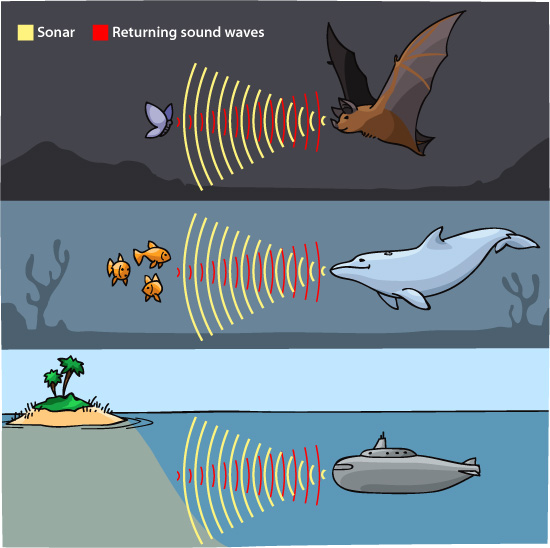We’ve all heard the description ‘as blind as a bat’ – but how blind is a bat, really? I mean, bats hunt insects with better  accuracy and success than I have with a fly swatter, and I have great eyesight (mostly).
accuracy and success than I have with a fly swatter, and I have great eyesight (mostly).
Well, it turns out that bats really aren’t all that blind. In fact, their method of ‘seeing’ is so impressive it has inspired the military to develop navigation technologies like sonar and radar. So how, exactly, do bats ‘see’?
Yes, bats see with their eyes, but they also ‘see’ with their ears. You probably know that a dog can hear high-pitched – or high-frequency – sounds that humans can’t. Maybe you know that elephants can hear very low frequency sounds beyond our range of hearing. Bats have sensitive hearing that can detect very high-frequency sound waves, even higher than what a dog can detect.
A bat will send these high-frequency sound waves out from its mouth and nose. The sound waves hit an object, creating an echo that bounces the sound waves back to the bat’s ears. The sound and speed of the echo gives the bat a lot of information about the object, including its size and shape and where it is. That helps the bat decide if it should fly around the object or eat it. This is echolocation.
Some insects can hear or feel the bat’s echolocation and will take evasive action. Have you ever seen bats swooping and darting as they hunt their dinner? It takes a lot of energy for one bat to chase down a few thousand insects each night!
Echolocation is very similar to radar and sonar. The military developed these navigation systems for undersea vessels and aircraft after studying bats and other animals, like dolphins, that also use echolocation.

ASU School of Life Sciences: Ask a Biologist
Echolocation can help a bat zip through a dense forest or snatch a moth out of the air, but sometimes echolocation fails.
Urban areas pose new risks for bats. New architecture with smooth modern lines has introduced vertical surfaces that throw off a bat’s echolocation and are mistaken as clear flight paths, rather than something solid.
A study tested a bat’s ability to detect smooth vertical and horizontal surfaces. When the test bats flew through a dark flight tunnel, 19 of 21 bats (that’s 90%!!) collided with smooth vertical plates that were placed in the tunnel. None – zero – of the bats collided with the horizontal plates. Clearly, bats are familiar with and even expect to encounter smooth horizontal surfaces, like water. Smooth vertical surfaces, though, are a surprise – and can be deadly.

Why don’t the bats detect these vertical surfaces?
Why does their echolocation appear to fail them?
It is even more important to ask how our design of buildings and cities impacts bats and other wildlife populations. Is there something we can do differently to prevent bats from colliding with the unnatural environment we have created? We have ‘whirly bird diverters’ to discourage birds from flying too close to power lines – can we do something similar to help the bats?
